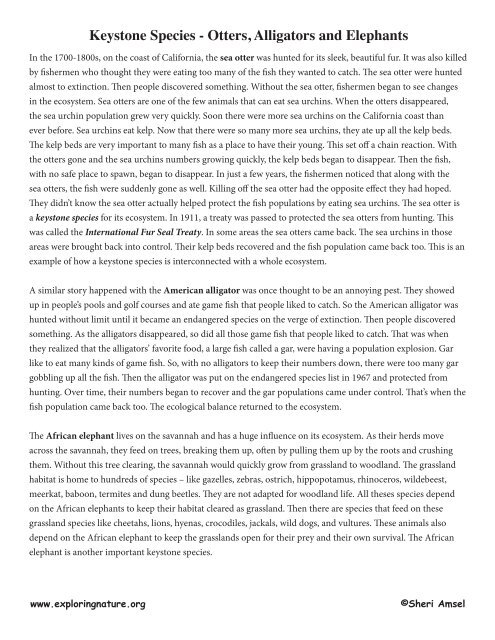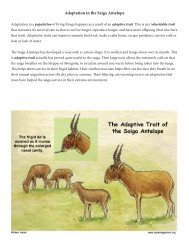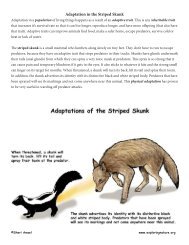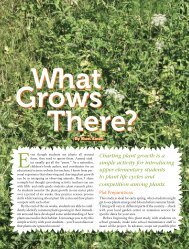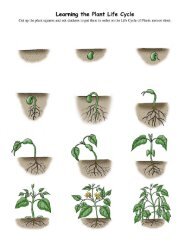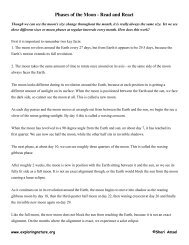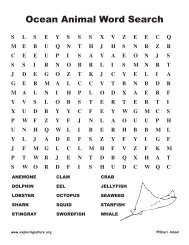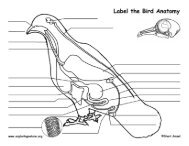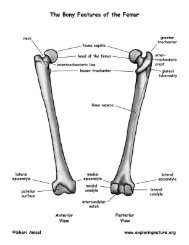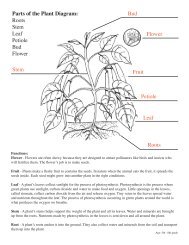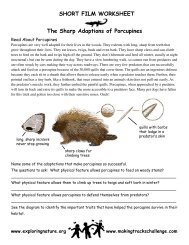Keystone Species - Otters, Alligators and Elephants - Exploring Nature
Keystone Species - Otters, Alligators and Elephants - Exploring Nature
Keystone Species - Otters, Alligators and Elephants - Exploring Nature
- No tags were found...
Create successful ePaper yourself
Turn your PDF publications into a flip-book with our unique Google optimized e-Paper software.
<strong>Keystone</strong> <strong>Species</strong> - <strong>Otters</strong>, <strong>Alligators</strong> <strong>and</strong> <strong>Elephants</strong>In the 1700-1800s, on the coast of California, the sea otter was hunted for its sleek, beautiful fur. It was also killedby fishermen who thought they were eating too many of the fish they wanted to catch. The sea otter were huntedalmost to extinction. Then people discovered something. Without the sea otter, fishermen began to see changesin the ecosystem. Sea otters are one of the few animals that can eat sea urchins. When the otters disappeared,the sea urchin population grew very quickly. Soon there were more sea urchins on the California coast thanever before. Sea urchins eat kelp. Now that there were so many more sea urchins, they ate up all the kelp beds.The kelp beds are very important to many fish as a place to have their young. This set off a chain reaction. Withthe otters gone <strong>and</strong> the sea urchins numbers growing quickly, the kelp beds began to disappear. Then the fish,with no safe place to spawn, began to disappear. In just a few years, the fishermen noticed that along with thesea otters, the fish were suddenly gone as well. Killing off the sea otter had the opposite effect they had hoped.They didn’t know the sea otter actually helped protect the fish populations by eating sea urchins. The sea otter isa keystone species for its ecosystem. In 1911, a treaty was passed to protected the sea otters from hunting. Thiswas called the International Fur Seal Treaty. In some areas the sea otters came back. The sea urchins in thoseareas were brought back into control. Their kelp beds recovered <strong>and</strong> the fish population came back too. This is anexample of how a keystone species is interconnected with a whole ecosystem.A similar story happened with the American alligator was once thought to be an annoying pest. They showedup in people’s pools <strong>and</strong> golf courses <strong>and</strong> ate game fish that people liked to catch. So the American alligator washunted without limit until it became an endangered species on the verge of extinction. Then people discoveredsomething. As the alligators disappeared, so did all those game fish that people liked to catch. That was whenthey realized that the alligators’ favorite food, a large fish called a gar, were having a population explosion. Garlike to eat many kinds of game fish. So, with no alligators to keep their numbers down, there were too many gargobbling up all the fish. Then the alligator was put on the endangered species list in 1967 <strong>and</strong> protected fromhunting. Over time, their numbers began to recover <strong>and</strong> the gar populations came under control. That’s when thefish population came back too. The ecological balance returned to the ecosystem.The African elephant lives on the savannah <strong>and</strong> has a huge influence on its ecosystem. As their herds moveacross the savannah, they feed on trees, breaking them up, often by pulling them up by the roots <strong>and</strong> crushingthem. Without this tree clearing, the savannah would quickly grow from grassl<strong>and</strong> to woodl<strong>and</strong>. The grassl<strong>and</strong>habitat is home to hundreds of species – like gazelles, zebras, ostrich, hippopotamus, rhinoceros, wildebeest,meerkat, baboon, termites <strong>and</strong> dung beetles. They are not adapted for woodl<strong>and</strong> life. All theses species dependon the African elephants to keep their habitat cleared as grassl<strong>and</strong>. Then there are species that feed on thesegrassl<strong>and</strong> species like cheetahs, lions, hyenas, crocodiles, jackals, wild dogs, <strong>and</strong> vultures. These animals alsodepend on the African elephant to keep the grassl<strong>and</strong>s open for their prey <strong>and</strong> their own survival. The Africanelephant is another important keystone species.www.exploringnature.org©Sheri Amsel
<strong>Keystone</strong> <strong>Species</strong> - <strong>Otters</strong>, <strong>Alligators</strong> <strong>and</strong> <strong>Elephants</strong> - Read <strong>and</strong> React1. What happened to the other species in the coastal waters when the sea otter was hunted almost to extinction:_____________________________________________________________________________________________________________________________________________________________________________________________________________________________________________________________________________________________________________________________________________________________________________________________________________________________________________________________2. What was the balance between the American alligator, the gar <strong>and</strong> the game fish?_____________________________________________________________________________________________________________________________________________________________________________________________________________________________________________________________________________________________________________________________________________________________________________________________________________________________________________________________2. How does the elephant keep the African savannah habitat right for the other animals living there?_____________________________________________________________________________________________________________________________________________________________________________________________________________________________________________________________________________________________________________________________________________________________________________________________________________________________________________________________www.exploringnature.org©Sheri Amsel


